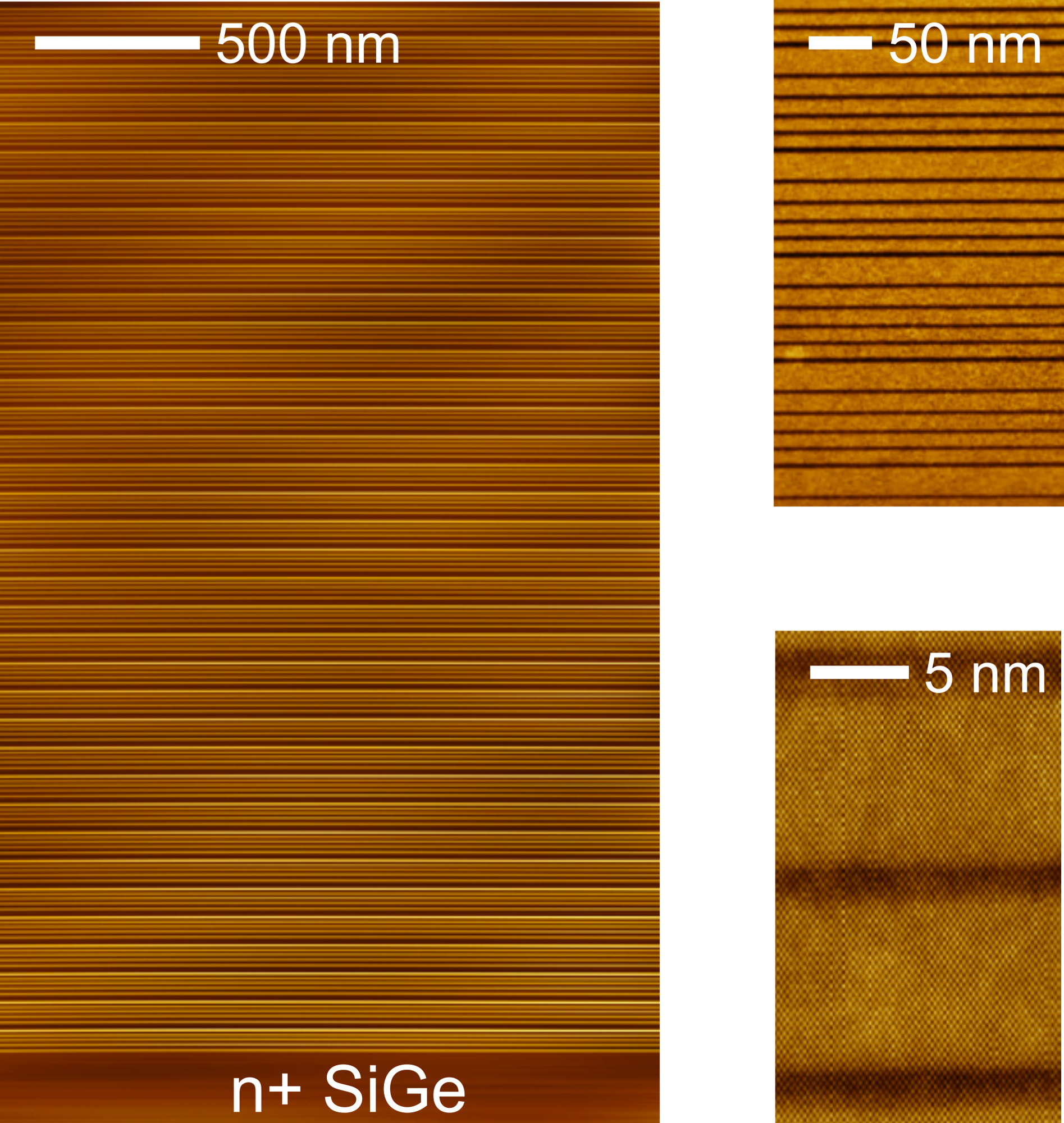Mar 9 2021
Among all the chemical elements, silicon is the one that stands apart especially where microelectronics is concerned. Silicon is the workhorse of the transistor technology that fuels the information society.
 Scanning transmission electron microscopy (STEM) images of one of the Ge/SiGe heterostructures at different magnifications. The SiGe layers appear darker. Image Credit: Università Roma Tre, De Seta Group.
Scanning transmission electron microscopy (STEM) images of one of the Ge/SiGe heterostructures at different magnifications. The SiGe layers appear darker. Image Credit: Università Roma Tre, De Seta Group.
The unlimited numbers of electronic devices that are used in daily life are a testament to how an excess quantity of silicon-based components can be created today at an extremely low cost.
It only seems natural to use silicon in other fields as well, in which the characteristics of semiconductors—as silicon is one—are technologically manipulated, and to find ways to incorporate different kinds of functionalities.
Diode lasers are of specific interest in this context, for example, those used in laser pointers or barcode scanners, which are generally based on gallium arsenide (GaAs). But regrettably, the physical processes that produce light in GaAs do not work efficiently in silicon.
Hence, it continues to be an exceptional, and long-held, objective to identify an alternative way to realize a 'laser on silicon.'
Writing recently in the Applied Physics Letters journal, an international research team headed by Professors Giacomo Scalari and Jérôme Faist from the Institute for Quantum Electronics has demonstrated a crucial step on how to obtain this kind of a device.
The team has reported electroluminescence—that is, the generation of electrical light—from a silicon-germanium (SiGe)-based semiconductor structure; SiGe is a material that can be used with regular fabrication procedures employed for silicon devices.
Besides this, the researchers observed an emission in the terahertz frequency band, sitting between those of infrared optics and microwave electronics. Today, the terahertz frequency band is attracting a great deal of interest with a view to a wide range of applications.
Make Silicon Shine
The primary reason why silicon cannot be directly used to build a laser based on the GaAs template can be attributed to the varying nature of their band gaps, which is indirect in the former but direct in the latter.
In short, electrons in GaAs again merge with holes across the bandgap, generating light; these electrons produce heat in the case of silicon.
Therefore, laser action in silicon demands another route. David Stark, a doctoral researcher from ETH, and his collaborators are now looking for a new approach. The team is working toward a silicon-based quantum cascade laser (QCL).
QCLs realize light emission not through the recombination of electrons and holes across the bandgap, but by allowing electrons to flow quickly through repeated stacks of accurately designed semiconductor structures, and photons are produced during this process.
For the first time, the QCL example was demonstrated in several materials back in 1994 by a research team that included Jérôme Faist, who was working at Bell Laboratories in the United States at that time; however, this paradigm was never demonstrated in silicon-based materials, in spite of promising predictions.
Changing these predictions into reality is the target of an interdisciplinary study, which is financially supported by the European Commission.
The project brings together a group of leading experts who specialize in growing the highest-quality semiconductor materials (at the Università Roma Tre), defining them (at the Leibniz-Institut für innovative Mikroelektronik in Frankfurt an der Oder) and creating them into devices (at the University of Glasgow).
The ETH team of Scalari and Faist is handling the measurements on the devices and is also taking care of the laser design, with theoretical and numerical support from associates in the company, nextnano, based in Munich and at the Universities of Rome and Pisa.
From Electroluminescence to Lasing
With this collective expertise and information, the researchers developed and constructed devices with a unit structure composed of SiGe and pure germanium (Ge), measuring less than 100 nm in height, which repeats as much as 51 times.
Based on these heterostructures, which were produced with essentially atomically accuracy, Stark and colleagues identified electroluminescence, as expected, with the spectral traits of the emerging light corresponding well with calculations.
A comparison with a GaAs-based structure produced with matching device geometry provides additional confidence that the devices function as planned.
While the emission from the Ge/SiGe structure continues to be much lower than that of its GaAs-based alternative, these outcomes clearly indicate that the researchers are on the right path.
The following step will be to organize analogous Ge/SiGe structures in accordance with a laser design developed by the team. The ultimate objective is to achieve room-temperature function of a silicon-based QCL.
An achievement like this would be important in many respects. After a long time, it would help achieve a laser on a silicon substrate and thus bring advancements to silicon photonics. The emission of the structures fabricated by Stark and team is in the terahertz region, for which compact light sources are extensively missing today.
Silicon-based QCLs, with their decreased fabrication cost and promising versatility, could be an advantage for the large-scale application of terahertz radiation in both new and existing fields of application, ranging from wireless communication to medical imaging.
Journal Reference:
Stark, D., et al. (2021) THz intersubband electroluminescence from n-type Ge/SiGe quantum cascade structures. Applied Physics Letters. doi.org/10.1063/5.0041327.